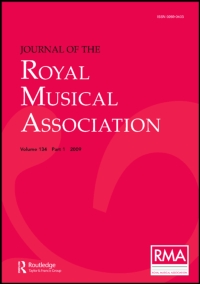No CrossRef data available.
Article contents
John Dunstable and the Music of his Time
Published online by Cambridge University Press: 01 January 2020
Extract
It is not the first time that your Association offers an opportunity to discuss the importance of John Dunstable in the history of music. I only recall the paper read by my esteemed colleague Professor Van den Borren who had the honour of speaking to you about The Genius of Dunstable seventeen years ago. Moreover, I am convinced that this paper will not be the last one on the same subject; for Dunstable is a figure who has a fascination which the contemporaries of the composer must already have felt more than we do to-day. The fame of Dunstable spread over the whole cultured world in a short time as the theorists of the fifteenth century give evidence and as the places of origin of the manuscripts which contain Dunstable's compositions prove. These sources were written in England, the Netherlands, France, Italy, Germany and even Spain. And still, in the sixteenth century when all preceding composers lived in the shadow of such masters as Okeghem and Josquin, Dunstable figures in public opinion as a mythical ancestor of music art, and is regarded even as the “inventor of counterpoint.” Though it is evident that this legend was nothing but a confusion it was seriously maintained by modern writers. It is true, Johannes Tinctoris, the greatest theorist about 1480, tells us in the introduction of his Ars Contrapuncti (1477) that the music of the last forty years was more perfect than all preceding music, and that only that music which was written by most excellent musicians as Dunstable, Dufay and Okeghem really was worth hearing. A Spanish monk goes so far as to add to Tinctoris's statement his own conviction that the music of these three masters was not only the best of that time but, also, not surpassable in the future.
- Type
- Research Article
- Information
- Copyright
- Copyright © Royal Musical Association, 1938
References
1 Proceedings of the Musical Association, XLVII, 1921.Google Scholar
2 As Victor Lederer and Henry Davey.Google Scholar
3 Printed in Coussemaker, Scriptores IV, 77.Google Scholar
4 Cf. the passage printed in Acta Musicologica, VIII, pp. 103–4.Google Scholar
5 In his Musica Practica (1496), Lib. II, C. 7.Google Scholar
6 This entry to which Prof. Handschin kindly drew my attention occurs in MS. 162 of St. John's College, Cambridge.Google Scholar
7 Cf. W. H. Grattan Flood, “The English Chapel Royal under Henry V and VI,” Sammelbände der Intern. Musikgesellschaft, X, p. 563.Google Scholar
8 Victor Lederer and Rudolf von Ficker.Google Scholar
9 Edited by the Plainsong and Mediaeval Music Society, 1933–38.Google Scholar
10 Cf. footnote 27.Google Scholar
11 In Sammelbände der Intern. Musikgesellschaft, II, 8.Google Scholar
12 “Ueber Leben und Werke von Dunstable” in Ada Musicologica, VIII, p. 102 (1936).Google Scholar
13 Cf. “Geschichte des Englischen Diskants und des Fauxbourdons” (Collection d'Etudes Musicologiques, Vol. 21). Strassburg, 1936.Google Scholar
14 Cf. H. Besserler: Studien zur Musik des Mittelalters, Archiv fuer Musikwissenschaft, VII, p. 188.Google Scholar
15 Cf. Van den Borren (footnote 1).Google Scholar
16 Flyleaves at the end of Incunabula C 47 (Pembroke College, Cambridge). The MS. was recently detached from the book; it has however no separate pressmark.Google Scholar
17 Cf. Manfred Bukofzer “The Gymel, the Earliest Form of English Polyphony,” Music and Letters, XVI, p. 77 (1935).Google Scholar
18 See footnote x.Google Scholar
19 The Worcester Antiphonar (F. 160), edited in Paleographie Musicale, XII.Google Scholar
20 Cf. Manfred Bukofzer “The First Motet with English Words,” Music and Letters, XVII, p. 225 (1936).Google Scholar
21 I gave an illustration of this type in the article quoted in footnote 17.Google Scholar
22 Paleographie musicale, XII, 370.Google Scholar
23 The music is printed in the Oxford History of Music (1905), ii, p. 155.Google Scholar
24 See footnote 1.Google Scholar
25 Cf. W. Barclay Squire's article on Dunstable. A shorter version of it without the music is to be found in the Dictionary of National Biography.Google Scholar
26 Cf. the conductus “Salve rosa” in Worcester Mediaeval Harmony (The Plainsong and Mediæval Music Society, 1928).Google Scholar
27 The Bologna MS. in which this motet appears was written before 1430.Google Scholar
28 Press mark: lat. 471.Google Scholar
29 Cf. W. Barclay Squire's copy in the British Museum (Add. 36490).Google Scholar
30 Here only those English composers are cited who occur in the Modena MS. The complete list of the English school would be much longer.Google Scholar
31 See Example VII.Google Scholar
32 By Mr. Turner, of Magdalene College.Google Scholar
33 On 22nd November, 1932.Google Scholar


